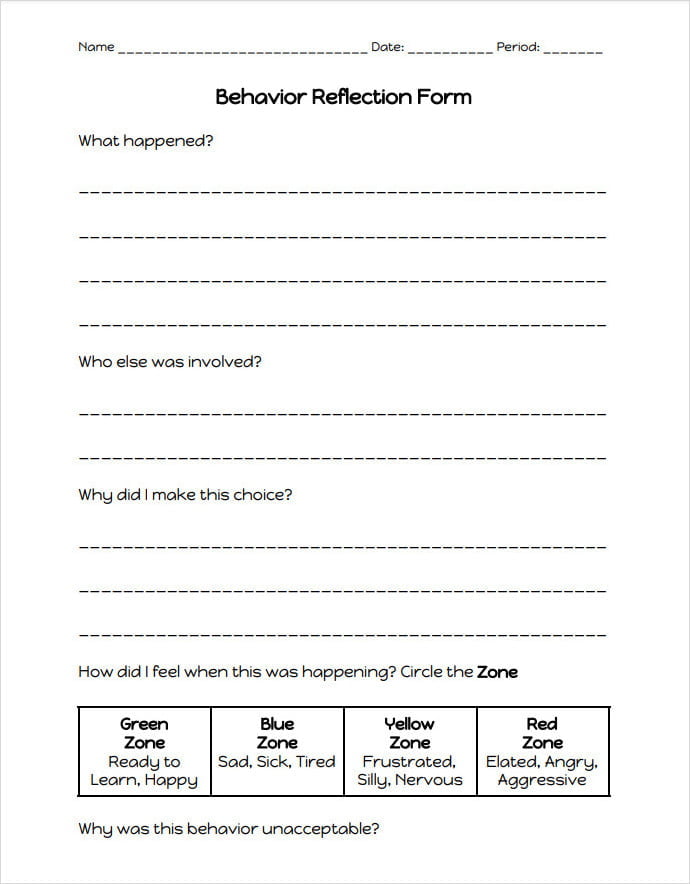Behavior reflection sheets are powerful tools that facilitate self-reflection, accountability, and personal growth in various settings, particularly in educational environments. These templates provide a structured framework for individuals to analyze their behavior, identify triggers, and set goals for improvement.
Whether tailored for adults or children, behavior reflection aims to encourage individuals to take ownership of their actions and understand the impact of their behavior on themselves and others. By fostering self-awareness and promoting a growth-oriented mindset, these templates serve as invaluable resources for individuals looking to enhance their behavior and interpersonal skills.

What is a Behavior Reflection Sheet?
A Behavior Reflection Sheet is a structured tool used in educational and group settings to help individuals reflect on their behavior, identify triggers, and set goals for improvement. It encourages self-awareness, accountability, and personal growth by guiding individuals through a process of analyzing their actions and making positive choices. Different templates cater to various age groups, ensuring a tailored approach to behavior reflection.



Benefits of Behavior Reflection Chart
This reflective tool serves multiple purposes:
1. Maintaining Order in the Classroom
Behavior reflection charts help maintain order in the classroom by providing a systematic way for students to analyze their behavior and understand the impact it has on the learning environment.
2. Giving Students a Transparent Indicator
By using behavior reflection charts, students are given a transparent indicator of their actions, allowing them to see patterns in their behavior and make informed decisions on how to improve.
3. Holding Students Accountable
These charts play a crucial role in holding students accountable for their actions, encouraging them to take responsibility and learn from their mistakes. This accountability fosters a sense of ownership and contributes to a positive and respectful learning environment.



Types of Behavior Reflection Sheet
1. The Classic Behavior Reflection
The Classic Behavior Reflection Sheet Template is a structured tool commonly used in educational settings to assist individuals, particularly students, in reflecting on their behavior and making positive choices. This template includes sections for recording incident details, reflecting on behavior, identifying triggers, and setting goals for improvement. It provides a systematic approach to analyzing behavior patterns and encourages individuals to take responsibility for their actions.
2. The Visual Behavior Reflection
The Visual Behavior Reflection Sheet Template is designed to incorporate visual elements to aid individuals in reflecting on their behavior. By including visual prompts or cues, this template can enhance the reflective process and make it more engaging and accessible, especially for visual learners. Visual aids can help individuals better understand their actions and the impact they have on themselves and others.
3. The Collaborative Behavior Reflection
The Collaborative Behavior Reflection Sheet Template promotes a cooperative approach to reflecting on behavior. This template encourages individuals to engage in discussions or activities with others to reflect on their actions collectively. By fostering collaboration, this template can help individuals gain different perspectives, insights, and support from peers or mentors, leading to a more comprehensive and enriching reflective experience.


The Behavior Reflection Sheet for Children
The Behavior Reflection Sheet for Children is a valuable tool designed to help young individuals reflect on their actions and make positive choices. Customizable with child-friendly prompts and engaging graphics, this template encourages personal growth and learning by guiding children to identify their behavior, understand expectations, and suggest improvements. It provides a structured approach for children to analyze their actions, take responsibility, and develop better decision-making skills.
By incorporating simple language and reflective spaces, the Behavior Reflection Sheet Template for Children fosters a constructive environment for self-reflection and behavior correction. With sections for defining expectations, reflecting on actions, and offering improvement suggestions, children are guided through a thoughtful process of understanding their behavior patterns and making positive changes. This template not only helps children learn from their mistakes but also involves parents and teachers in the corrective process, promoting accountability and personal development.


How to Create a Behavior Reflection Sheet
Creating a Behavior Reflection Sheet template involves several key steps to ensure its effectiveness in helping students reflect on their behavior and make positive changes.
- Identify the Behavior: Clearly state the behavior that needs correction.
- Define Expectations: Outline the expected behavior in simple language.
- Reflection Space: Provide a dedicated area for students to reflect on their behavior.
- Behavior Improvement Suggestions: Allow students to suggest better ways to behave.
- Teacher’s Observations and Comments: Include a section for teacher feedback.
- Parental Signature: Add a line for parental involvement and awareness.


Final Thoughts
Behavior reflection sheet templates are indispensable tools that promote self-awareness, accountability, and personal growth in various settings. By encouraging individuals to take responsibility for their actions, these templates serve as powerful instruments for fostering positive behavioral change.
Emphasizing accountability, they empower individuals to recognize the impact of their behavior on themselves and others. In educational and collaborative environments, behavior reflection sheets facilitate communication and support constructive discussions among teachers, parents, and supervisors. These templates play a vital role in cultivating a reflective and growth-oriented mindset, guiding individuals toward continuous improvement and development.